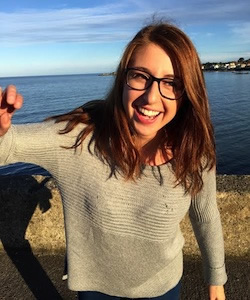“It isn’t about what football team you join, but about which paramilitary unit you join to feel a part of something and to feel cool,” my classically dark-humored, “History of Terrorism” tour guide commented as we strolled through a normal European city: Belfast, Northern Ireland. But, normal it was not.
Just when I thought my investigations into religious terrorism might be fruitless on this particular island, I uncovered a legacy of abnormality that I will never forget. Although the city no longer has the reputation of being “more bombed than Baghdad,” the tensions and divides between the Protestant British (the “occupiers”/loyalists/unionists) and the Catholic Irish (the “occupied”/nationalists) remain poignantly ripe still today. Both sides since “The Troubles” have come to normalize an abnormal lifestyle.
One Belfast native I encountered shared that during his first visit to Boston in the early 1990s, he walked into a pub and—without thinking—stalled at the entrance with his hands in the air waiting and expecting to be patted down before entering; this was the protocol for entering any given pub in Belfast for the best part of 30 years. Luckily for him, the Bostonians chalked up his little incident to just being “wicked” weird and continued drinking with an Irish fervor. But that was 20 years ago—how has it not changed since?
Walking around at 8 p.m. on an early Saturday evening in October, my friend and I were wondering why something felt so off. We didn’t expect Belfast to be much different from Dublin, but then we realized what it was that we couldn’t put our finger on: there were no people. Wandering the streets of Belfast’s city center and circling its opulent City Hall—a relic to Ulster’s economic heydays during the Industrial Revolution—we saw no one except a few fellow tourists comfortably nestled into bars or pubs for an early evening. Excuse me—what? An early evening? It was a Saturday night! But as we were soon to learn, even in the 20 years that saw Belfast grow from having just one hotel, Hotel Europa—the most-bombed hotel in the world—to the 80-plus hotels it boasts today, Belfast never shook the trauma of the ruthless terrorist attacks on innocent party-goers to nightclubs and pubs. As a consequence of this internalized legacy of abnormality, few surface late at night, and even fewer tourist-hub establishments stay open later than midnight on the weekends—a drastic difference from their out-all-night counterparts in Dublin. One Northern Irish person I met, the grandson of an Irish Republican Army member, blamed the Protestants and their religiously-bent laws for Belfast’s “party conservatism,” but it unmistakably ran deeper than just religion.
All I knew was that I sure wasn’t in Dublin anymore. This became even clearer the next day during our “History of Terrorism” tour when something unexpected happened: we didn’t go anywhere that we hadn’t been before. At first I was confused and somewhat irritated—as the restless tourist here to learn I had a laundry list of things left to see and sights left to Instagram—but then I realized what it meant to revisit all the places I’d been before. It meant that I took Belfast’s facade of normalcy for granted: where now may stand an H&M or a tourist-ridden “Traditional Irish” restaurant, before stood something else or perhaps the same thing: a local establishment smack dab in middle of the city that was bombed during “The Troubles.” No need to get imaginative...these restaurants, bars, and nightclubs that witnessed the taking of innocent lives did not house terrorist masterminds nor harbor fugitives for either side; they were just there. They were the old normal until they were attacked, and there has been no real new normal since—just building in its place.
However, I would have never realized the historical significance of the 20-some-odd storefronts I had walked by before if not for a tour guide pointing them out. This seemed crazy to me. In the United States, we have a plaque to recognize the largest ball of yarn, yet the Northern Irish didn’t have official commemoration of these historic sites of terrorism. There are no plaques not because the pains of those 30 years of bitter violence are not still felt, but for the very opposite reason: those tensions are still not resolved. Simply put, the Northern Irish to this day cannot compromise on how to portray and memorialize the sites of terrorism, so they have kept them unmarked.
Granted, there is the “Peace Wall” in the western neighborhoods of Belfast, which recognizes the struggles and lives lost on both sides. The wall also includes a mural that likens the occupier/occupied binary to the situation in Palestine and Israel… but that’s a topic best saved for my final blog entry. Until then, I will leave you with this: whether you’re Protestant, Catholic, or simply curious venture to Belfast and see this strange city for yourself—just don’t forget to order your last drink before midnight.

